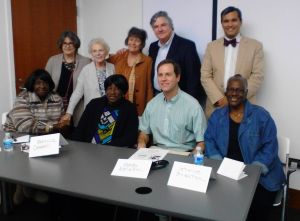Voted the Best Place to See by Condé Nast Traveler.

By Ruth Ellen Gruber, Norman and Gerry Sue Arnold Distinguished Visiting Chair at the College of Charleston

In March, descendants of Drayton Hall—both Drayton family members and descendants of the enslaved—participated in a panel discussion at the College of Charleston. Standing (l to r): Ruth Ellen Gruber, Lainie Lesser-Mark, Dale Rosengarten, George McDaniel, Grant Gilmore. Seated (l to r): Annie Meyers, Rebecca Campbell, Shelby Nelson, and Catherine Braxton.
More than 20 years ago I wrote a book called Upon the Doorposts of Thy House: Jewish Life in East-Central Europe, Yesterday and Today. The title referred to the mezuzah—the encased prayer scroll Jews place on their doorposts, indicating a house as the home of a Jew.
In post-Holocaust Europe you could often find the grooves or scars where mezuzahs had been removed or painted over during or after the Shoah—thus forming symbolic mezuzahs that indicated a house where Jews once lived. In my book, I extrapolated further, suggesting that the surviving physical relics of pre-war Jewish life—synagogue buildings, Jewish cemeteries, even if abandoned, in ruined condition or transformed for other use, also served as symbolic mezuzahs to mark towns, villages, cities, and even countries where Jews once lived and do not live now.
My intent was to show how buildings and other physical sites can be talismans and touchstones, opening the way into memory and history.
George McDaniel made this same idea explicit in his introduction to the panel of Drayton Hall descendants. “History did not happen to someone, somewhere else, but to you,” he said. “You grow up a product of history. Preserving buildings means also preserving the story behind the buildings, making a connection with people. Why is a place important? How do you feel connected?”
From the Jewish perspective, visiting Jewish historical sites in post-Holocaust, post-Communist Europe can be a very positive experience, emphasizing Jewish life, history and culture; but the experience also falls under what is now known as Dark Tourism—tourism to sites of what we can call “negative” history, “negative” experience: death, destruction, war.
Sites of slavery also fall under Dark Tourism, though this aspect of a historic site (such as a plantation or genteel antebellum home) often becomes masked, elided, or simply footnoted in the presentation of beautiful buildings and gardens for tourist consumption.
Much of this boils down to “who controls the narrative”—and to whom is the narrative directed: issues that we have been dealing with in the class I have been teaching, “Memory, Heritage, Renewal.” Although the main focus of our class is Jewish heritage and memory and their role and representation in Europe, we have been able to draw parallels with the way that African American heritage, history, and culture are presented here in Charleston and the Lowcountry.
I was delighted that students from my class were in attendance at the panel presentation featuring the descendants of Drayton Hall, as the discussion clearly demonstrated the parallels we have been dealing with, touching on issues such as the point of view of interpretation and interpreters; messages and signage; how the same place can have different symbolic meanings and generate different memories for different people.
I found particularly compelling a part of the film about Drayton Hall’s African American descendants that parallels the post-Holocaust Jewish experience in Europe. People were filmed sitting in the African American cemetery at Drayton Hall, speaking about how many of the deceased buried there had no markers for their graves, no one to talk about their history. In Eastern Europe, when I visit an abandoned Jewish cemetery, I often ponder the fact that most of the thousands and thousands of people buried in these places are also forgotten, with no descendants to tend their graves or even remember who they were.
Drayton is not alone in trying to present a more inclusive past in the plantation context. Boone Hall has installed an extensive presentation on slavery and African American history centered on the nine preserved slave cabins there. Magnolia Gardens features special programs to bring to life its recently renovated row of cabins. And Middleton Place, which I have not yet visited, presents a permanent exhibit titled “Beyond the Fields” in a two-family tenant residence called Eliza’s House, in memory of Eliza Leach, a South Carolina African American born in 1891, and the last person to live in the building. The much less elaborate Hampton Plantation also incorporates the site’s slave history in well researched text panels, both in the Big House and along the path leading to it.
After the Drayton Hall panel, I was excited to visit McLeod Plantation with Mary Battle, public historian at the Avery Research Center for African American History and Culture, and her class. McLeod, which served as local headquarters of the Freedman’s Bureau following the Civil War, has the potential to interpret not only slave life but the postwar experience of the newly freed men and women. McLeod’s signage uses a phrase that could be the site’s “slogan”—describing it as a place of both “tragedy and transcendence.” I found it interesting that this formulation echoes what we sometimes call sites of Jewish heritage in Europe—“sites of tragedy and sites of triumph.”